ISSN ONLINE(2319-8753)PRINT(2347-6710)
ISSN ONLINE(2319-8753)PRINT(2347-6710)
| Patange Vidyut Chandra Assistant Professor, Department of Mechanical Engineering, Sreenidhi Institute of Science and Technology , Ghatkesar, Hyderabad , Andhra Pradesh , India |
| Related article at Pubmed, Scholar Google |
Visit for more related articles at International Journal of Innovative Research in Science, Engineering and Technology
This paper focuses on the crucial area of productivity improvement with the astute use of work study technique mixed with modern soft skills. . Management needs to understand its application not just from angle of production improvement or finance improvement or resource utilization, but also should address critically the soft side of workers psychology to give the best to not only for accepting the productivity solutions, but also be a part on forefront during actual implementation to make the study really worth its time and effort. The systematic application of method study, and time study to improve productivity, reduce costs and improve profits.
Keywords |
| Productivity, process improvement, work study, time study, method study, managerial role, soft skills, trainings |
INTRODUCTION |
| Productivity is the relationship between output and input. It actually means adding value to input to enhance value of output. Productivity can be achieved by enhancing the value-added content of products/services, or by decreasing the unit cost of production, or a combination of both (Erlendsson, J. 2006). At present all process is considered from the angle of productivity to reduce the non-value activities to give optimized output to the possible extent. It is a total concept that addresses the key elements of competition, for example is innovation, cost, quality and delivery (Erlendsson, J. 2006). |
| A. To identify areas for potential productivity improvement projects based on statistical data collected during the analysis. |
| B. To determine possible productivity improvement objectives and potential cost savings (Anonymous, 2000). |
| C. The ability to estimate potential savings based on the analysis results (Anonymous, 2000) |
LITERATURE REVIEW |
| The application of science to business problems, with the use of time-study methods in standard setting and the planning of work, was pioneered by Frederick Winslow Taylor, with emphasis on fair day work. The study reveals that lots of coordination efforts was put with managerial positions to prepare the path for human relations to supersede scientific management in terms of literary success and managerial application. The very fact that the oral management was converted to scientific management, with all facts, data analysis to enhance productivity irrespective of the physiological cost to the worker. Gilbreth (1909), Cadbury and Marshall heavily criticized Taylor and pervaded his work with subjectivity. Cadbury in reply to Thompson stated that under scientific management employee skills and initiatives are passed from the individual to manage, they relied heavily on individual interpretations of what workers actually do and Gilbreths were charged with the task of proving that motion study particularly, and scientific management generally, increased industrial output in ways which improved and did not detract from workers' mental and physical strength. |
DEFINITIONS AND OBJECTIVES |
| A. DEFINITION OF METHOD STUDY, FROM THE 3RD EDITION OF THE INDUSTRIAL ENGINEERING HANDBOOK [2] The technique that subjects each operation of a given piece of work to close analysis to eliminate every unnecessary element or operation and to approach the quickest and best method of performing each necessary element or operation. It includes the improvement and standardization of methods, equipment, and working conditions: operator training; the determination of standard time; and occasionally devising and administering various incentive plans. |
| B. DEFINITION OF METHOD STUDY |
| Definition of Time study from the McGraw-Hill Science & Technology Dictionary: A work measurement technique, generally using a stopwatch or other timing device, to record the actual elapsed time for the performance of a task, adjusted for any observed variance from normal effort or pace, unavoidable or machine delays, rest periods, and personal needs. |
| C. OBJECTIVE OF PRODUCTIVITY STUDY |
| Productivity studies analyze technical processes and engineering relationships such as how much of an output can be produced in a specified period of time, (Toronto Globe and Mail, 1995). It is related to the concept of efficiency, which is the amount of output produced relative to the amount of resources (time and money) that goes into the production. |
APPROACH FOR PRODUCTIVITY ENHANCEMENT. |
| .A PRODUCTIVITY |
| It provides measures of the efficiency of production. Productivity is a ratio of production output to what is required to produce it (inputs). The measure of productivity is defined as a total output per one unit of a total input. |
| B. DEFINITIONS OF PRODUCTIVITY |
| Productivity is the effective use of innovation and resources to increase the value-added content of products and services. It is the true source of competitive advantage that creates long term economic viability and a better standard of living for all. |
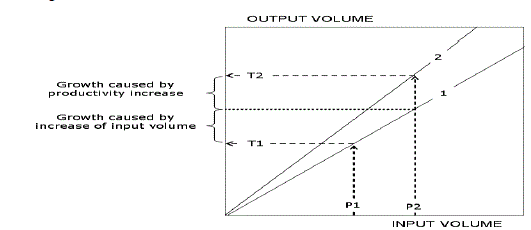 |
| Fig ïÂÂ(a) Source:Saari, S.: Productivity. Theory and Measurement in Business. European Productivity Conference. Espoo, Finland |
| PRODUCTIVITY IMPROVEMENT TECHNIQUES |
| There are two techniques that have been developed in the past to improve productivity |
| By reducing work content |
| By reducing ineffective time |
 |
DESIGN OF APPROACH IMPLEMENTATION |
| Identified processes which are of a repetitive nature, were scrutinized for problems related high costs, time to focus and apply the method and time study techniques to improve productivity. The proposed process of improving productivity was indeed lauded and many find the idea very attractive and accept it readily. Usually acceptance or rejection depends upon such things as tradition, experience, feelings of the members and officers, the group's strength as a bargaining unit, the type of plan being offered, its benefits, and relations with management. |
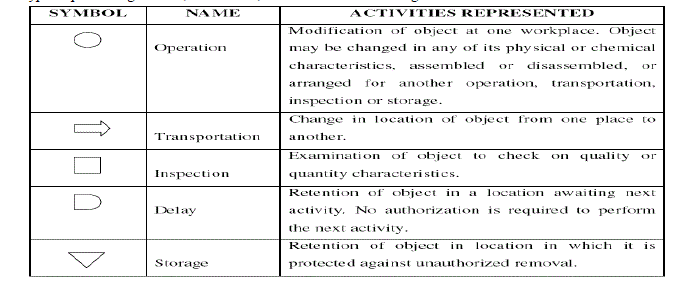 |
| A: PROCESS MAPPINGS |
| The first step we adopted during the process mapping is to determine how the flow or sequence of steps/activities that is required to complete a process task is maintained during actual working. This information was gathered through the routine interviews (Anonymous, 2001). As we felt it could be of great benefit to the people working in different areas of the company, with the correct information or activities that flow from one department to the other. Flowcharting a process did help in organizing the tagging various activities for process mapping. Indeed it was a major task to acquire information on every process/path that takes place to complete a task. |
| B: WORK SAMPLING |
| We adopted the Work Sampling on random to observe the worker(s) at randomly selected times and recording the type of activity that is observed at that instance (Industrial Time Study, 2000). Work sampling is most commonly used to collect information for allowance calculation, to determine the distribution of work activities, and to determine the productive and non-productive utilization of workers. |
| C. ESTIMATE NUMBERS OF OBSERVATIONS REQUIRED |
| Goal: to limit the error in the estimate of the mean operation time (OT) to plus or minus a given percentage, k. Equation to estimate n, no# of observations needed: |
 |
| A pilot study is conducted by taking a small set of observations or use historical data to estimate the parameters: |
| D.CALCULATED MEAN OT: |
| xp (mean operation time observed in the pilot study), use xp as an estimate of x for the full scale study and Sample standard deviation, s. |
| You get 25 readings, x1 through x25: 0.28, 0.24, 0.33, 0.33, etc. |
| When you summarize your data, you find: |
| xp = Ó xi /25 = 0.30, where xp is the average time required to perform the work element. |
| s = Ó (xi – xp)2 = [(.28-.30) + (.24-.30) + …]2 = 0.09 |
| √ n – 1 √ 25 – 1 |
| Use s = 0.09 from the pilot study to estimate s for the larger study. |
| Full scale study: how many observations of an element do you need to take in a larger time study, in order be 95% confident that your measurement of x is within k = 5% of the true value? |
| k = 5% (acceptable error) á = 1 – confidence level = 1 - .95 = .05 From pilot study we estimated: xp = Ó xi = 0.30, s =0.09 Now you need to look up t. You can look up t if you know á and the degrees of freedom (d.o.f): |
| d.o.f. = np - 1 = 25 – 1 = 24 |
| n = t s = 2.064 x 0.09 = 153.3 observations |
| K x 0.05 x 0.30 (round up to an integer) |
ANALYSIS OF WORK CONTENT USING METHOD STUDY |
| Methods analysis is concerned with the reduction of the work content of a job or operation, while work measurement is typically concerned with any ineffective time associated with the method and subsequent establishment of time standards for the operation. Method study, provided tools for looking at processes critically in order to improve their performance. The main areas covered during analysis were as below. |
| Activities performed |
| Operators involved |
| Equipment and tools used |
| Materials processed or moved |
| The job data were critically examined and challenged on their viability and necessity (purpose, place, sequence and method)., also due analyzed it from the manufacturing prospective ness and coordination of resources; we found that process time includes many non valued activities so our first aim of study was to reduce the processing time through reducing ineffective time. Proposed an alternative method those are suitable to form the base for the new work instructions. The operator views were considered on allowances and problems faced in real scenarios, and during the process documentation to make them as important stakeholders, this made the process friendlier as well as acceptable by operators. Then operators were provided with training on new work instructions, by an industrial engineer for 2 days. Upon which a control documented procedures released to monitor the performance and sustain the changed process, thus preventing drifting back to previous methods of work will also be introduced. (Refer: Attached as Annexure table 1 to 3) from others doing the same work. This is due to differing speeds of movement, effort, dexterity and consistency (Keyserling, 2000). Direct observation techniques (such as time study and analytical estimating) include a process for converting observed times to times for the "qualified worker working at a defined level of performance. (Anonymous, 2001)" The commonest of these processes is known as rating. Basic time = observed time x observed rating/standard rating Standard time= Basic time + allowances |
| A PERSONAL DELAYS |
| These are included to perceived time necessary for maintaining the general well being of the employee. This includes, for example; trips to the rest room and water cooler. Working conditions, temperature at the workplace, a person’s physical health, etc. all effect personal time needs. |
| B MISCELLANEOUS DELAYS |
| They are used to pay for random interruptions of the worker caused by influences outside his or her control. Interruptions by supervisors, material irregularities, or malfunctioning equipment are examples. These "lost" times must be accounted for in the standard. Not allowed are interruptions and delays that are the fault of the worker, such as: excessive personal time or rework because of poor workmanship. |
| C FATIGUE ALLOWANCES |
| They are closely associated with personal time needs and the types of work being done. Throughout the years, as heavy or undesirable work became mechanized, fatigue allowances have been reduced proportionately. This trend is good because fatigue is hard to validate and is subject to much argument. |
TIME STUDY |
| Time Study is the analysis of a specific job by a qualified worker in an effort to find the most efficient method in terms of time and effort. Time Study measures the time necessary for a job or task to be completed using the best method. Accumulative time study is made for determining time standards. |
| Establish reasonable productivity targets for experienced workers, |
| Provide productivity goals for training purposes, |
| Eliminate waste, |
| Make processes more consistent |
| Reduce variability, improve quality |
TIME STUDY PROCEDURE |
| Time study conducted for measuring work in process. Before making this time study each operation was broken into definite number of elements, which are not large or too short in time, then selected average cooperative operator(s) The stopwatch time study is used to analyze a specific process by qualified workers in an effort to find the most efficient ways in terms of time. Moreover, this method measures the time necessary for a work process to be completed using the best ways. The time was measured using snapback stopwatch equipment because it is easier and faster in data recording. Moreover, this type of stopwatch is suitable for this research because it can develop accurate data. This allows the element times to be entered directly on the time study sheet without the need for subtractions. Observe operators performing a task: record time taken for each element, over several cycles. Our objective is to record the time taken to perform an activity and to give the ratings of that activity. Assign appropriate allowances (e.g. Allow time for necessary but non-productive activities, such as rest, cleaning eyeglasses, etc. Determine appropriate work standards, with the objective to eliminate idle activities and to set a new standard time to calculate the standard time of each operation. |
RESULTS OBTAINED AFTER THE STUDY |
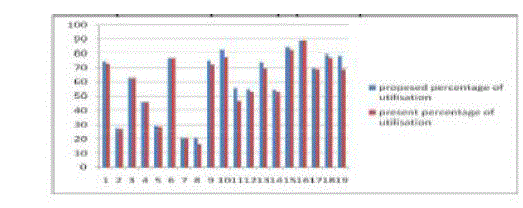 |
| Applying principles of work study the process time of PCD solid reamer in reduced from 55.36 hours to 52.01 hours. |
PRODUCTIVITY IMPROVEMENT |
 |
BENEFITS FROM THIS STUDY |
| This study was chosen because it will give many benefits to production and operation management. Among the advantages for organization in producing their PCD solid reamers are: |
| A.ELIMINATE THE UNNECESSARY |
| Knowing what is unnecessary is important as knowing what is the most important in production and operation. Based on those, we can eliminate insignificant tasks and nonproductive activities. Preoccupation, layout of production, errors, too much motion and travel during performing the tasks are examples of nonproductive activities and it wasted the production time. |
| B. CHANGE THE SEQUENCE OF OPERATIONS |
| Changing the sequence of operations based on the process chart and flow diagram to affect a smooth flow of work through plant, which can reduce production time. Besides that, changing the sequence of operation also involve the layout of production, where it can reduce space utilization. |
| C. SIMPLIFY THE NECESSARY OPERATIONS |
| Simplify the necessary operations to make the job easier by analyzing the process in order to improve through elimination, combine or rearrange the sequence and layout of operations. By simplifying the operations, it can also effect for the production time. |
`CONCLUSION |
| Some employee groups refrain from any comment until after the methods and rates have been established, taking action on disagreement through the grievance procedure. This technique may vary from the use of observers who merely check and suggest to trained personnel who make motion and time studies in cooperation with company engineers. |
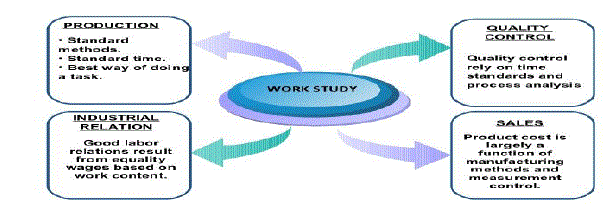 |
| Increases in productivity also can influence society more broadly, by improving living standards, and creating income. They are central to the process generating economic growth and capital accumulation. Productivity helps an organization to not only in increasing economy at micro level benefiting at both financial as well as labor performance output standard. But still in today’s organization I feel that total factor productivity, by contrast, captures the contribution to output of everything except labor and capital: innovation, managerial skill, organization, even luck. But finally we conclude that this technique adopted depends entirely upon the complexity of the labor-management relationship that exists in each individual situation. |
ACKNOWLEDGMENT |
| I take this opportunity to thank all experts , who have contributed their efforts for research and study to enhance the productivity in manufacturing sector using the method and time study. |
References |
|
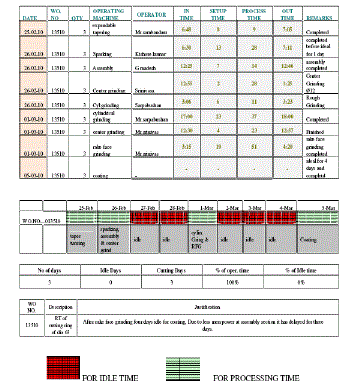 |
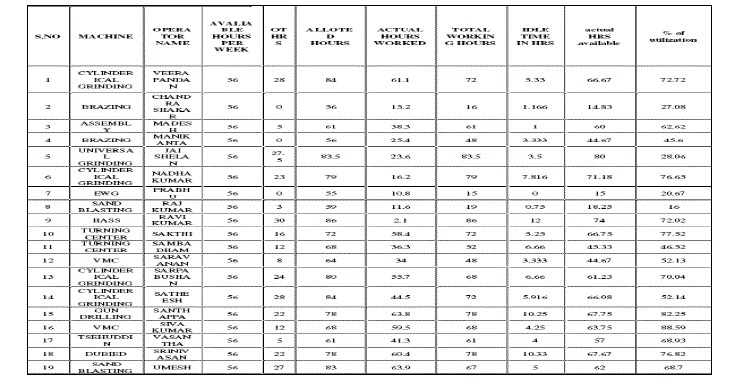 |